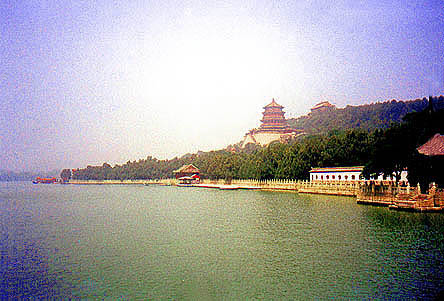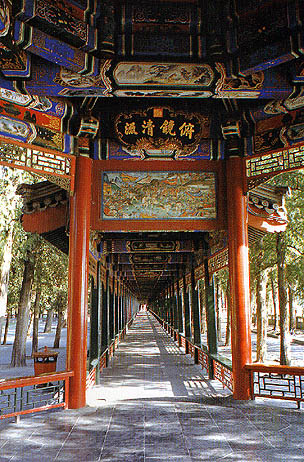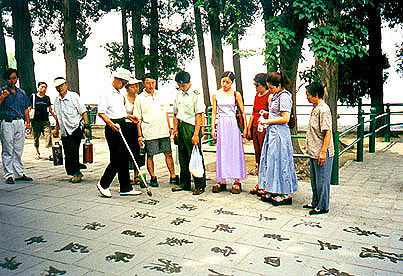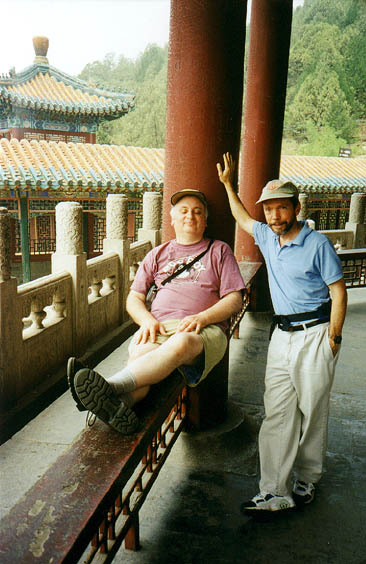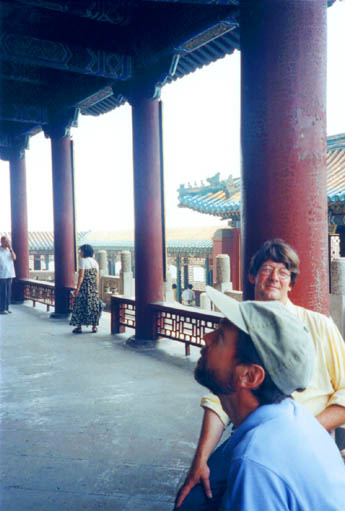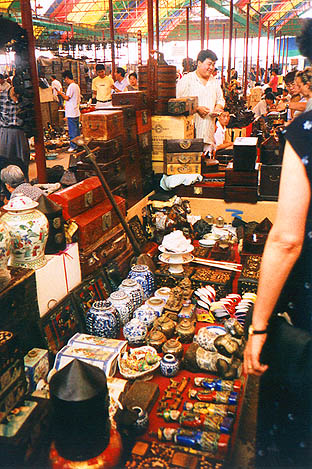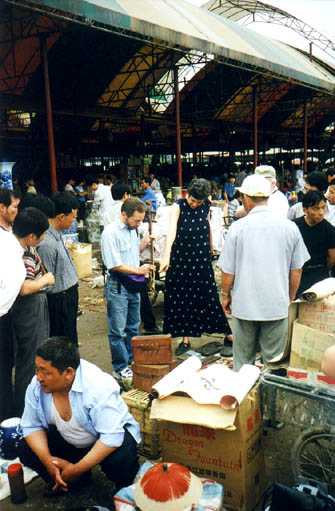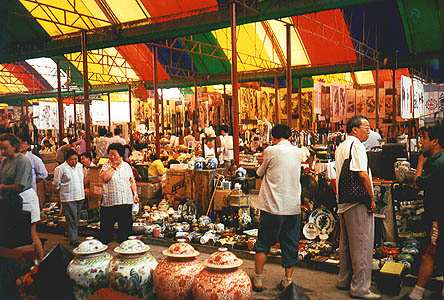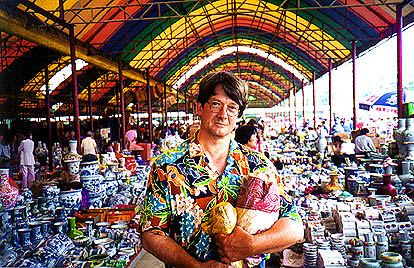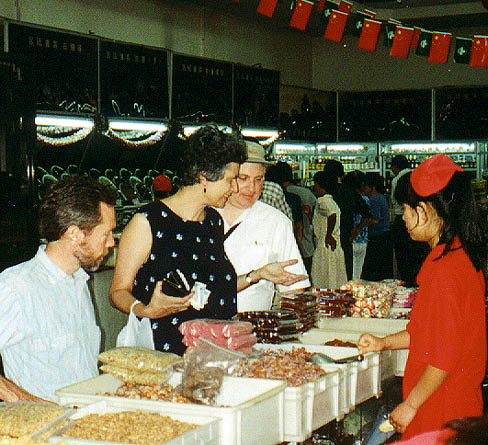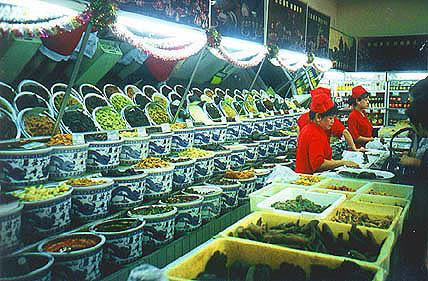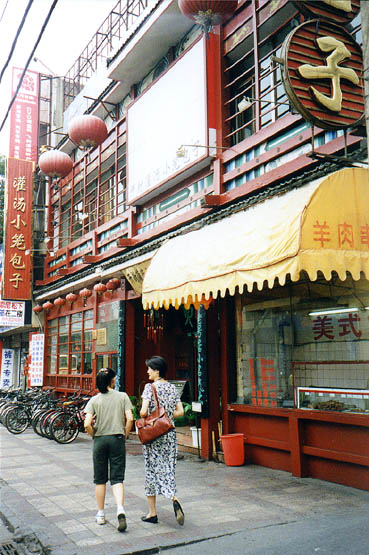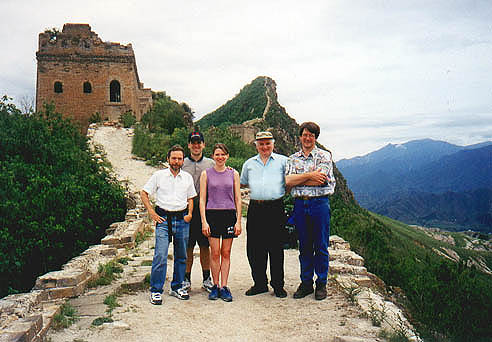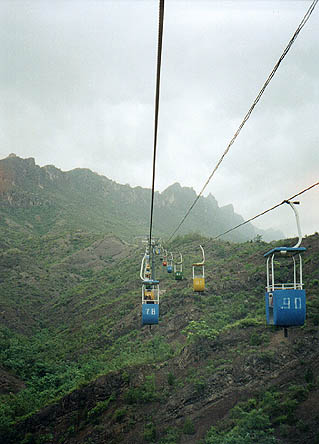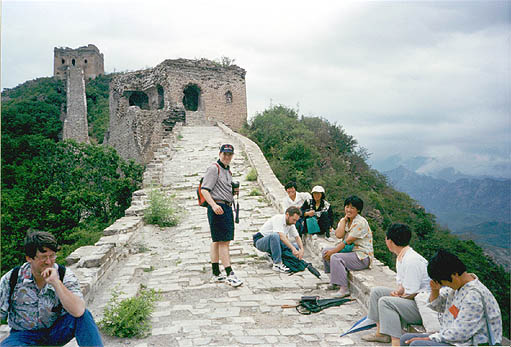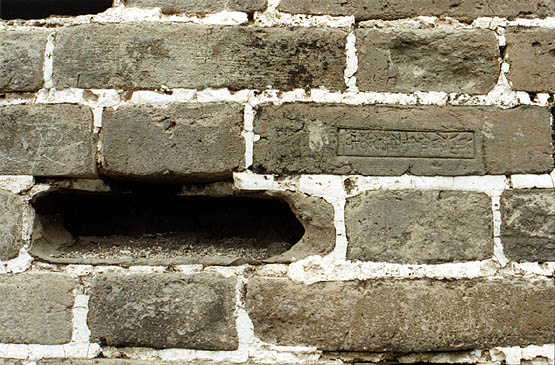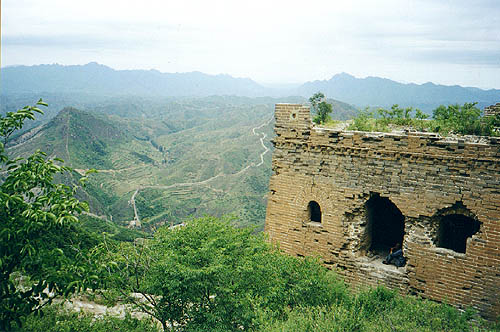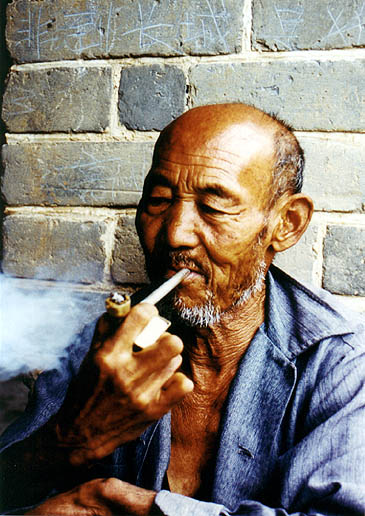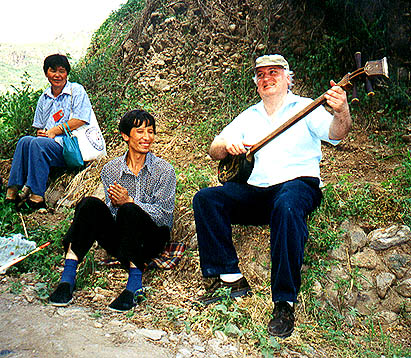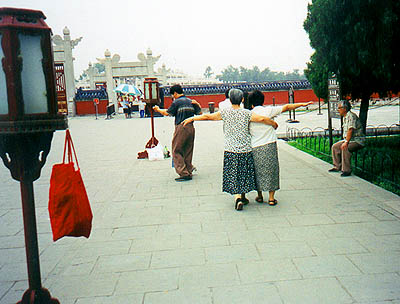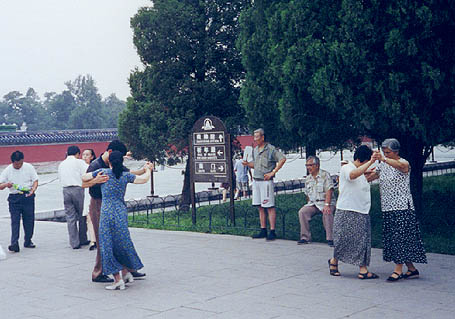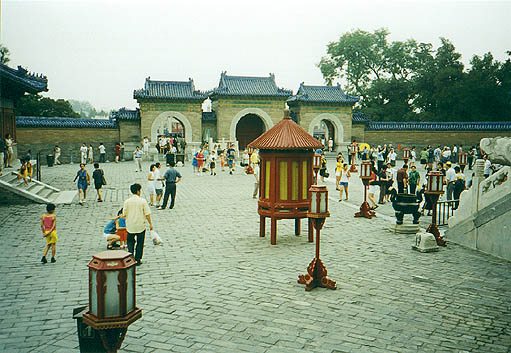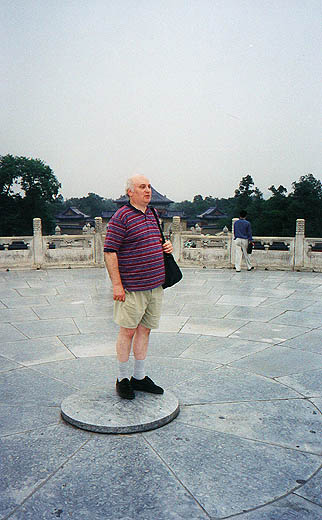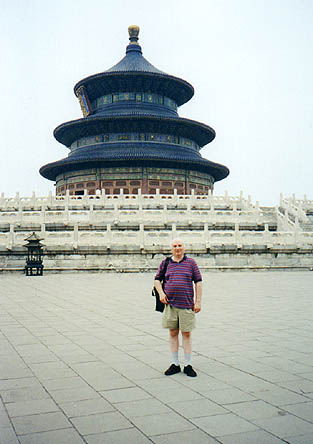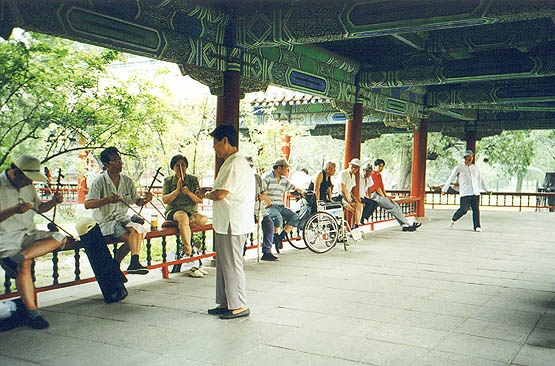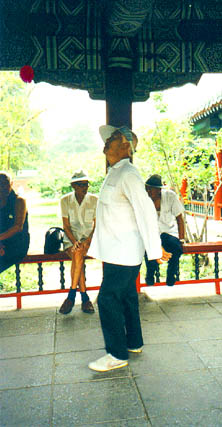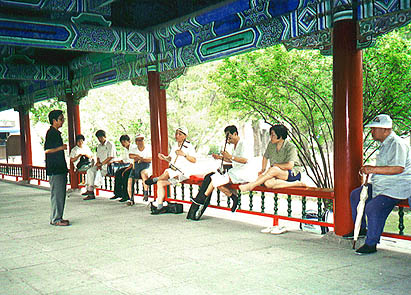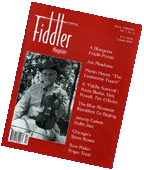Visiting the Summer Palace
Never mind the cats.
Painting calligraphy on the sidewalk with plain water and a large brush;
we think he was writing poetry.
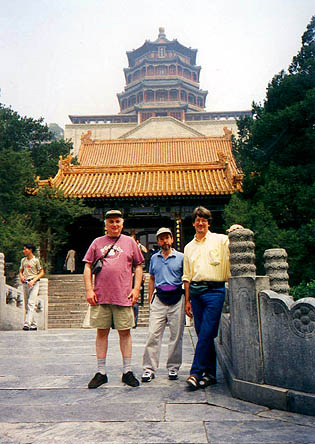 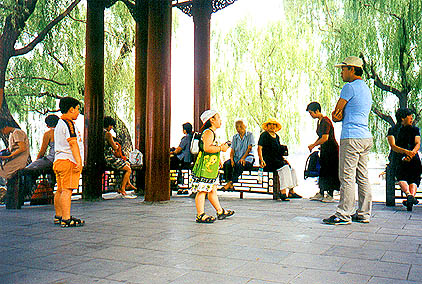
Here in the Heralding Spring Pavilion, a little girl and her brother
pester their stern father for an ice cream. In this photo he appears immovable,
but they prevailed.
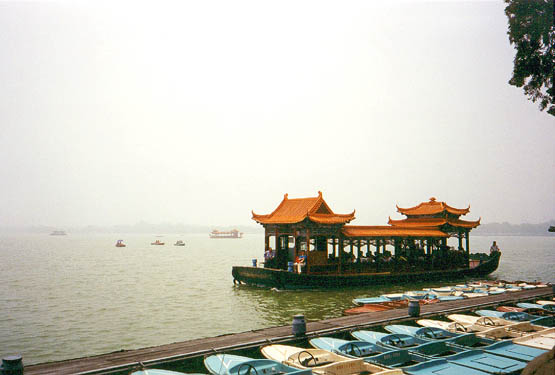 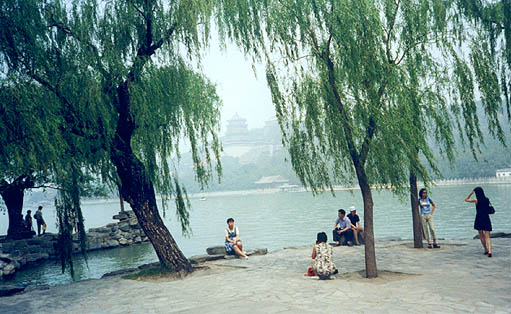 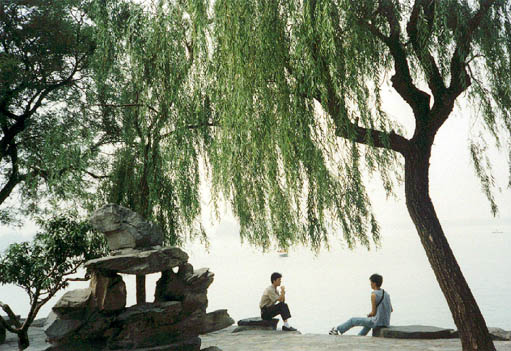 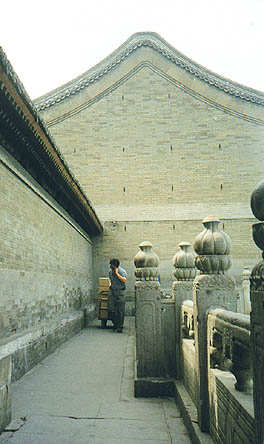
This is your typical Beijing guy - working his tail off while talking
on his cellphone. China never got wired in the first place, so it is entirely
wireless now - far ahead of the US in this regard. Everyone has cellphones,
from farmers in the country to the average Joe walking down the street
in town. They have much better manners about cellphones in China than they
have here too, I might add.
The Dirt Market
Suzanne Hale took us to a number of her favorite
places, including the "Dirt Market," a huge antique and would-be antique
market. We of course saw Tienanmen Square, the largest town square in the
world, passing Mao's tomb and a whole lot else as part of various journeys,
including this one. With Suzanne, we also found ourselves wandering the
hutongs, small neighborhood streets and alleys where the older, pre-high
rise enclosed family compounds are, through little markets where no white
tourists had probably ever been before, and to carpet dealers in obscure
little alleys. More about the carpet dealers on the next page.
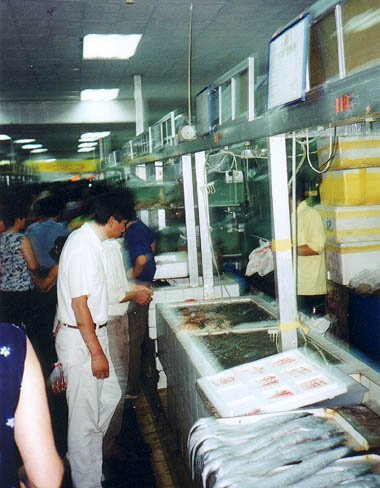
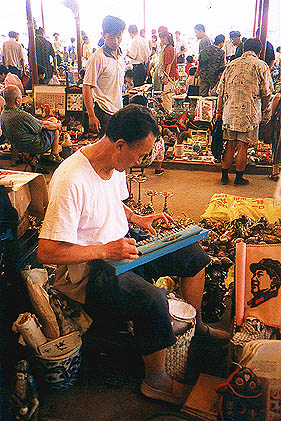
Qianmen Pickle Market 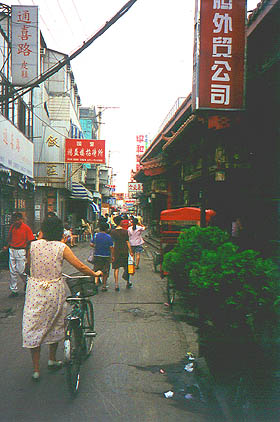 We continued to some of Suzanne's other favored
destinations including a pearl market, a killer Kaifeng-style restaurant
(see below), and this ancient pickle market in a neighborhood of streets
too small to carry vehicles. This was in the Qianmen Street zone, below
Tienanmen Square, a place we returned to several times. This pickle market
was unforgettable.
Heath, Suzanne and Jody admiring the goods;
Suzanne bought pickled peanuts for a cab-ride snack. YUM!
Each stoneware crock here has a different
pickled something in it. We carted a lot of pickle back into California
that came from this store. You cannot get this stuff here, unfortunately.
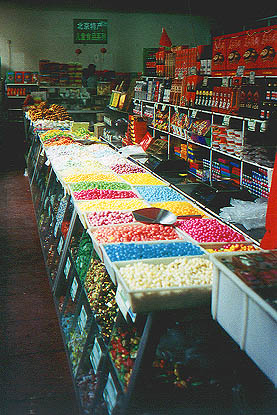 Candy is one of the major food groups in China, as elsewhere.
This is the restaurant of very happy tummies: No. 1 Dumpling of Kaifeng! Thank you, Suzanne Hale!
Great Wall at Simatai On a Saturday, we finally got out of town to visit the Great Wall with Peter Moustakerski, our USDA liaison, who was up from Shanghai for the event, along with his sweetie Laura Burt, who edits a business weekly in that city. The five of us were fortunate enough to have the use of the Embassy's Chevy van with its delightful driver, Mr. Sun (everyone in China was introduced by first names with the notable exception of Mr. Sun). We took the advice of a guidebook and went to Simatai, a stretch of the wall that's farther from town and much less touristy.
For once, a guidebook had it right! The Wall
offered spectacular views of Mongolia and northern China on either side.
Our journey there was augmented immeasurably by a little ad hoc army of
"guides" - five local women who attached themselves to each of us at the
entry down in the town and who sprinted up the mountain and arrived at
the Wall before our tram arrived.
Goin' up on a mountain...
For hours, our guides (below) stuck to us like affable shadows, cheerfully chatting up a storm about which tower was which, and so on. Several hours later, as we prepared to descend the hill and head back to Beijing, they moved in for the kill, with their bags of books, T-shirts and so on. Peter and Laura, both fluent in Chinese, had gone ahead just a bit, and suddenly, we three Blue Mountain Tourists were surrounded! In China, one is expected to haggle and bargain over most things, but these gals were formidable. Even Heath, with his Black Belt in bargaining, met his match in their tag-team approach to selling high. They whined and hammered. We finally succumbed to their pitches, parting with more kwai than necessary, but we got out OK.
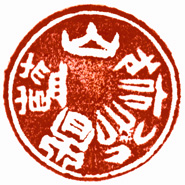 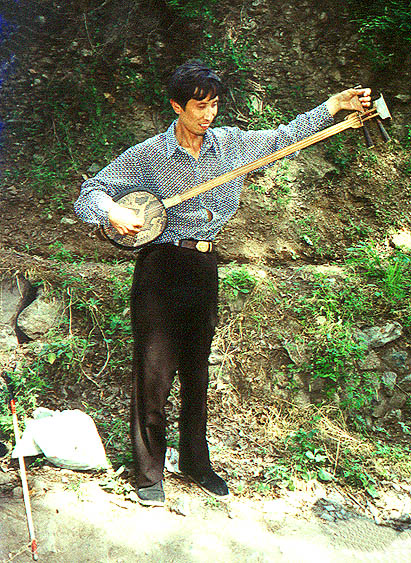
There was one last real bonus to our little journey out to Simatai. We'd asked one of our jolly guides if there were any local musicians thereabouts, and she replied yes, there was a blind singer. Her description didn't sound terribly promising, so we thought little more about it, but somehow, before we got out of the village at the end of the day, she'd sent word that some Americans wanted to meet the musician. We were actually in Mr. Sun's van just headed back toward Beijing when we spotted a young man with a white cane, sanxian slung over his back, tapping his way along the road toward where we had just left. We brake for sanxian players! Having hastily pulled over, we jumped out
to accost Wang Gung Cai, and were rewarded with an impromptu roadside concert
which began with renditions of "Yankee Doodle," "Doe, a deer, a female
deer," and "Oh Susanna" in honor of our coming all the way from California.
This charming young man played the large "country style" sanxian (sahn-shyen,
which simply means "three strings") of the north, as opposed to the more
delicate smaller version used in Chinese chamber music. He regaled us with
several other pieces, songs and instrumentals. At one point, he passed
the sanxian to Jody, who frailed a credible version of Yankee Doodle.

In the southern part of Beijing, the Temple of Heaven covers an area of a little more than a square mile. The main buildings in what is now a lovely city park were built in the Ming Dynasty in 1420 for worshipping heaven and the earth, and its extraordinarily complex landscaping is overlain with circles and squares, including some fascinating acoustic spaces for folks who like to whisper and sing. And dance the tango too.
This very large round plaza was one of the 'remarkable acoustic spaces.' If you put your head very close to the perimeter wall, you could whisper messages to someone else far along the same wall, and be quite audible despite the cacophony of the folks in the middle of the plaza. The joint was jumping that day, too.
Around the temple itself is a huge garden, with museums and covered arcades, lawns and groves of trees. Here we encountered the fiddlers, and what a jovial, spirited lot they were. Chinese fiddling is not expressed in whispers! 
While the fiddling was instantly accessible,
the singing was otherworldly to our ears. We could never fathom how the
singers knew when to come in, as the structure of the tunes was, to our
uninitiated ears, utterly obscure. Moreover, the Peking opera vocal style
was given forth in a stentorian laser-beam falsetto, utterly unlike western
vocal styles. But it all clearly went together, and the impromptu sessions
were a thrill to listen to and watch.
 Jody mused that the tradition of just hanging
out in public places to play for the joy of playing seems to have vanished
in America; nowadays, folks seem to need to either busk or have a stage
on which to perform. If the Blue Mountain Ramblers ever get back to Beijing,
I'd like them to go out to the Temple of Heaven with some instruments and
just sit on a ledge in the long arcade by the gardens and play tunes like
the neighbors there did. Then we'd finally have that cultural exchange!
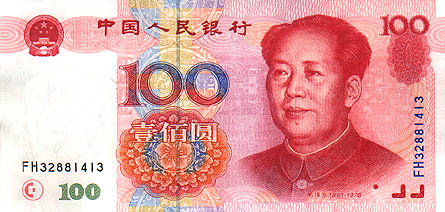
Want to keep going? Bravo! Click here to go to page three or page four 
This site began as a practice version of an article I
wrote for The Old Time Herald, and that article has been published.
Click here to read Jody Stecher's
different and quite wonderful article which he wrote for Fiddler Magazine This little scrapbook is a work in progress. More pictures
are bound to come, and more jabber to go with them. Check in again.
last fooled with on 25 February 2001 |
